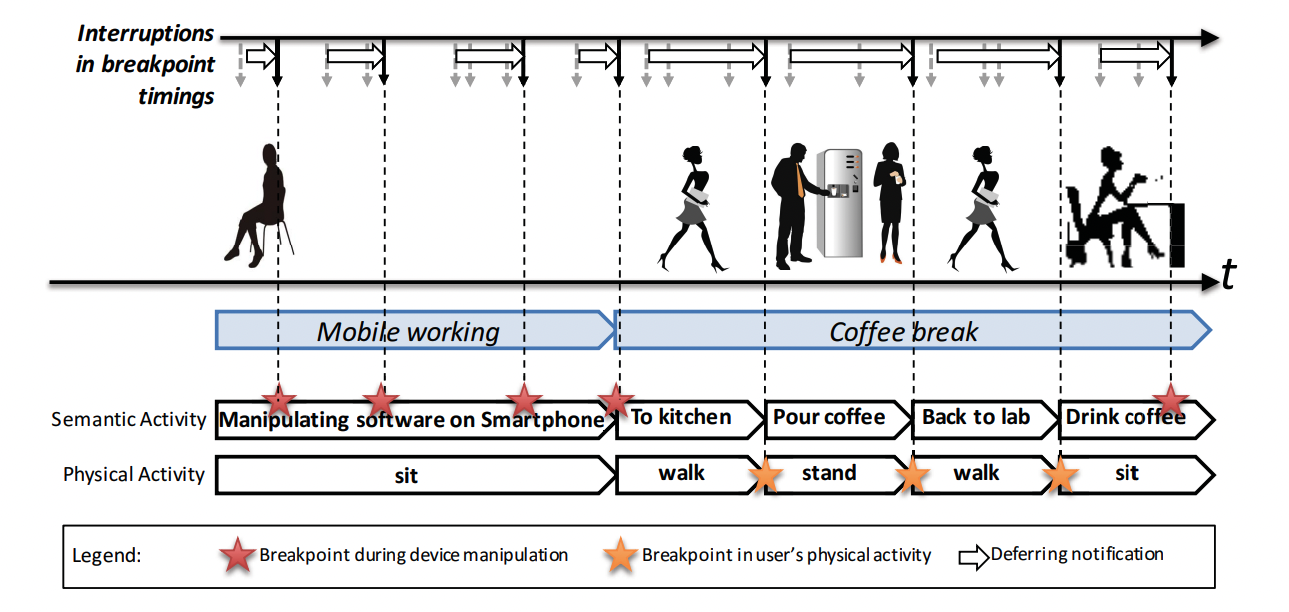In today’s ubiquitous computing environment where users carry, manipulate, and interact with an increasing number of networked devices, applications and web services, human attention is the new bottleneck in computing. It is therefore important to minimize a user’s mental effort due to notifications, especially in situations where users are mobile and using multiple wearable and mobile devices. To this end, we propose Attelia II, a novel middleware that identifies break-points in users’ lives while using those devices, and delivers notifications at these moments.
Attelia II works in real-time and uses only the mobile and wearable devices that users naturally use and wear, without any modifications to applications, and without any dedicated psycho-physiological sensors. Our in-the-wild evaluation in users’ multi-device environment (smart phones and smart watches) with 41 participants for 1 month validated the effectiveness of Attelia. Our new physical activity-based breakpoint detection, in addition to the UI Event-based breakpoint detection, resulted in a 71.8% greater reduction of users’ perception of workload, compared with our previous system that used UI events only. Adding this functionality to a smart watch reduced workload perception by 19.4% compared to random timing of notification deliveries. Our multi-device breakpoint detection across smart phones and watches resulted in about 3 times greater reduction in workload perception than our previous system.
The proposed system was then deployed in the actual product stack of Yahoo! JAPAN Android apps, and several significant results were confirmed, including a 10-fold gain over the previous system, a significant improvement in the degree of personalization of notification content, and unexpectedly good performance even in unusual breaking news notification situations The system also achieved a significant improvement in the degree of personalization of notification content. Based on these results, the proposed system has been officially deployed to all users in the Yahoo! JAPAN product environment, which is used by over 10 million Android app users, and is reaping the benefits.

研究成果
- T. Okoshi, K. Tsubouchi, and H. Tokuda, “Real-World Large-Scale Study on Adaptive Notification Scheduling on Smartphones,” Pervasive and Mobile Computing, vol. 50, pp. 1–24, 2018.
- T. Okoshi, K. Tsubouchi, M. Taji, T. Ichikawa, and H. Tokuda, “Attention and Engagement-Awareness in the Wild : A Large-Scale Study with Adaptive Notifications,” in Proceedings of IEEE International Conference on Pervasive Computing and Communications 2017 (PerCom ’17), 2017, pp. 100–110. (Best Paper Award Nominee)
- T. Okoshi, J. Nakazawa, and H. Tokuda, “Interruptibility research: opportunities for future flourishment,” in Proceedings of the 2016 ACM International Joint Conference on Pervasive and Ubiquitous Computing Adjunct – UbiComp ’16, 2016, pp. 1524–1529.
- T. Okoshi, J. Ramos, H. Nozaki, J. Nakazawa, A. K. Dey, and H. Tokuda, “Reducing Users’ Perceived Mental Effort Due to Interruptive Notifications in Multi-Device Mobile Environments,” in Proceedings of the 2015 ACM International Joint Conference on Pervasive and Ubiquitous Computing (UbiComp ’15), 2015, pp. 475–486.
- 大越匡, 野崎大幹, J. Ramos, 中澤仁, A. K. Dey, and 徳田英幸, “ユーザの認知負荷を軽減する情報提供タイミングの検知,” 情報処理学会論文誌, vol. 56, no. 10, pp. 1944–1958, Oct. 2015.